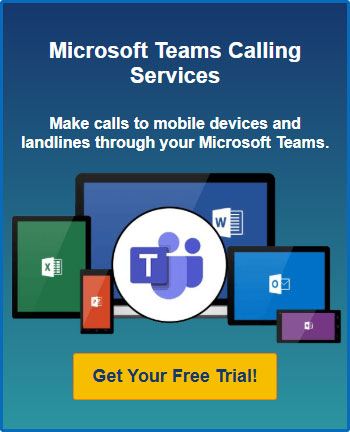Call a Landline from Teams
Build a Scalable Microsoft Telephone System
Posted on November 25, 2025 by Fusion Connect
Most companies feel the pressure to give employees tools that keep communication smooth—inside the company and out. Microsoft Teams handles meetings, messaging, and internal collaboration well, but many organizations still lack a simple way to make external phone calls.
Adding the ability to call landlines and mobile phones directly from Teams closes that gap. It keeps communication unified, secure, and ready to grow as your business does.
Why Expanding Teams with External Calling Matters
Microsoft Teams has become a go-to tool for meetings, chat, and collaboration—but many organizations still need a way to make and receive phone calls to landlines and mobile numbers. For IT leaders, expanding Teams into a full business phone system is about more than adding features. It’s about supporting the way business actually works—both inside and outside the organization.
Here’s why enabling external calls from Microsoft Teams makes a measurable difference:
- Business continuity and reliability:
A connected phone system keeps communication running during outages, office closures, or transitions. It supports emergency calling, voicemail, and call forwarding to maintain availability. - Employee productivity:
Teams users can manage meetings, chat, and phone calls from a single platform. No more switching between apps or devices to reach a customer or follow up with a vendor. - Enhanced Collaboration
Teams offer a suite of collaboration tools, including chat, video conferencing, and file sharing. Adding the ability to call landlines enhances these collaboration opportunities, ensuring no stakeholder is left out of the communication loop. - Customer experience:
Whether a contact uses a mobile phone, traditional phone, or Teams, your employees can respond directly using the same tool they use for internal communication. - IT oversight:
Centralizing phone calls, meetings, and collaboration in Microsoft Teams improves visibility. IT can monitor usage, enforce security, and support compliance—all from one control point
By unifying internal collaboration and external communication through Microsoft Teams, organizations simplify their workflows while giving IT more control. With the right calling setup in place, Teams becomes more than a productivity app—it becomes a fully functional business phone system.
Comparing Microsoft Teams Voice Deployment Options
Extending Microsoft Teams with external calling turns it into a full-featured business phone system. But before you can make calls to landlines or mobile phones, you need to decide how to connect Teams to the public phone network. IT leaders have three main options—each with unique benefits and trade-offs depending on business size, infrastructure, and in-house expertise.
Direct Routing with SIP for Maximum IT Control
Direct Routing connects Microsoft Teams to a telephony provider using a SIP Trunk. This option gives IT teams full control over the phone service, including custom configurations, call routing rules, and security settings.
It's a strong fit for organizations with complex environments or existing telephony investments. Direct Routing supports integrations with on-premises systems, like PBXs or call centers, and gives flexibility around carrier selection and pricing.
But that flexibility comes with added responsibility. IT teams must manage the infrastructure, setup, and ongoing maintenance, which can be resource-intensive for lean teams.
UCaaS-Hosted Voice for Cloud-First Simplicity
UCaaS-hosted voice services pair Microsoft Teams with a cloud-based telephony backend managed by a provider. This model is ideal for organizations that want the power of Microsoft Teams calling without managing the technical components themselves.
Hosted voice simplifies deployment and maintenance. Your service provider handles the VoIP infrastructure, calling features, and updates. It's a great choice for companies operating across multiple locations or supporting hybrid and remote workforces.
This model typically supports faster rollout and can scale more easily, but it offers less flexibility than Direct Routing when it comes to carrier choice and system customization.
Operator Connect for Speed and Reliability
Operator Connect is a Microsoft-approved way to connect Teams to a PSTN carrier—without needing manual configuration. It offers direct integration between Microsoft and participating service providers, which simplifies setup and allows faster deployment.
This option is perfect for IT teams looking for a balance of control and convenience. It keeps phone number provisioning, call management, and support with the operator, while allowing Teams admins to manage settings through the Teams admin center.
While it may offer fewer advanced customization options than Direct Routing, Operator Connect delivers enterprise-grade reliability, call quality, and support through a Microsoft-certified network.
Quick Comparison: Teams Calling Deployment Models
Here’s how the three options stack up across key decision factors:
Scalability
- Direct Routing: High, but IT-driven
- UCaaS: Very scalable with provider support
- Operator Connect: Easy to scale through Microsoft and partners
Cost
- Direct Routing: Carrier-dependent, more predictable long-term
- UCaaS: Bundled pricing, may include add-ons
- Operator Connect: Typically priced per user or line, variable by provider
Complexity
- Direct Routing: High technical complexity
- UCaaS: Low, handled by provider
- Operator Connect: Medium, managed through Microsoft portal
IT Control
- Direct Routing: Full control
- UCaaS: Limited control
- Operator Connect: Moderate control through Microsoft tools
There’s no one-size-fits-all approach to enabling external calling in Microsoft Teams. Each method—Direct Routing, UCaaS-hosted voice, and Operator Connect—offers a different mix of control, scalability, and simplicity.
IT leaders should align their choice with their team’s skill set, existing infrastructure, and voice strategy. Whether you need full customization or a plug-and-play option, Microsoft Teams can become a powerful business phone system with the right deployment model.
Unlocking Enterprise Features in a Unified Phone System
Adding Microsoft Teams calling isn’t just about making phone calls—it’s about building a cloud-based phone system that can scale. Features like auto attendant, simultaneous ring, advanced call routing, and call queue support keep incoming calls organized and responsive, even in fast-moving environments.
Unified communications through Microsoft Teams combines voice, video calls, chat, and calendar features into one interface. This integrated experience supports smoother collaboration, especially when managing internal calls across departments or geographic locations.
Teams-enabled IP phones, desk phones, headsets, and conference room devices can make external calls feel just as natural as internal ones. Whether you’re managing calls in an office, from a mobile phone, or via the Teams app, users benefit from a consistent and high-quality experience.
Business continuity is also built into the Microsoft Teams phone system. With teams phone features like call history and voicemail accessible across Teams devices, employees can recover missed calls and messages with ease—even during outages or travel. This ensures no conversation is lost, even in unexpected situations.
Advancing IT Strategy with Modern VoIP and Teams
Legacy telephone lines and private branch exchange (PBX) systems no longer meet the needs of hybrid and remote-first workforces. Modern VoIP through Microsoft Teams calling brings voice communication in line with the rest of your Microsoft 365 ecosystem.
VoIP adds flexibility and scalability that PBX capabilities can’t offer. Phone numbers are no longer tied to desks or buildings. With a cloud-based phone system, users can make and receive external calls wherever they have an internet connection—no special hardware needed.
For IT departments, Microsoft Teams VoIP means easier administration. Call quality can be monitored using built-in analytics, while updates and new calling capabilities are rolled out automatically. The system grows with your business—without needing extra hardware or manual upgrades.
This approach aligns with cloud-first IT roadmaps. By moving away from traditional telephony and adopting Teams Voice, infrastructure leaders can build a communication strategy that is mobile-ready, secure, and easier to support long term. For organizations using Direct Routing, a session border controller is often deployed to manage PSTN connectivity.
Building an IT-Ready Voice Strategy Step by Step
Start by reviewing your current telephony setup. Whether you rely on desk phones, mobile devices, or traditional phone services, mapping out how end users make and receive calls today can uncover key gaps and opportunities.
Next, align your needs to a Microsoft Teams calling model—SIP-based Direct Routing, UCaaS-hosted voice, or Operator Connect. Each has pros and cons, and the best fit depends on your business size, in-house expertise, and flexibility needs.
Run a network assessment to check bandwidth and call quality thresholds. Voice requires stable, high-quality connections, especially when scaled company-wide. Many service providers offer tools to test for VoIP readiness across locations.
Once ready, start with a pilot rollout. Choose a small group of users to test call control, voicemail, the dial pad experience, and features like transfer calls. If you're evaluating premium tools like Teams Premium or Copilot, this is the time to gather feedback on AI-powered call management or productivity features.
Ongoing monitoring is key. Use call history data, call queue metrics, and quality reports to track how your Teams phone service is performing. With the right feedback loops, IT teams can continue optimizing call forwarding, simultaneous ring, and other features over time.
Expanding Microsoft Teams with Voice Through Fusion Connect
Microsoft Teams becomes a true business phone system when paired with the right calling solution. Fusion Connect delivers Microsoft Teams Calling Services tailored to the needs of IT leaders who want more than just basic telephony.
Whether you’re deploying via Operator Connect, Direct Routing, or need a hybrid approach, Fusion Connect helps you roll out quickly—without giving up control. Keep your existing phone numbers or request new ones. Our flexible calling plans and VoIP capacity adapt as your team grows.
Beyond voice, Fusion Connect extends Teams with business texting, contact center tools, and call analytics. Add features like voicemail transcription, call recording, and integrations with your CRM or helpdesk. And with international support and 24/7 reliability, you’re covered wherever business takes you.
Speak to Our Tech Experts
We’ve helped organizations across industries modernize their phone systems inside Microsoft Teams—and we’re ready to help you do the same.
Article orginally published December 20, 2023 by Fusion Connect.



